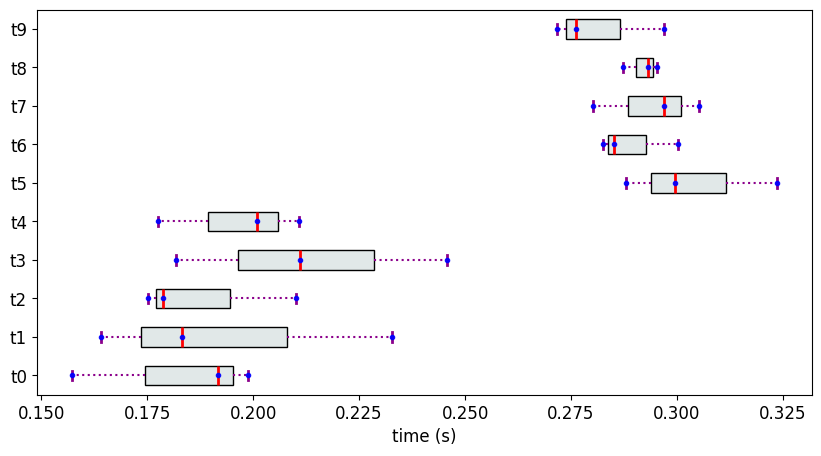PartialRankerReduced
Experiments with reducing the number of ranks computed by DFG based partial ranking methodology. In order to follow, please refer to Methodology 2 in the paper.
Experiment 2
We refer to the measurement data from the previous section. Recall, 10 objects are created, each with 3 measurement values sampled from 2 different normal distributions that are well-separated.
[5]:
from partial_ranker import MeasurementsSimulator, MeasurementsVisualizer
n1 = [0.2, 0.02]
n2 = [0.3,0.02]
M4 = {}
for i in range(5):
M4['t{}'.format(i)] = n1
for i in range(5,10):
M4['t{}'.format(i)] = n2
ms = MeasurementsSimulator(M4,seed=2)
ms.measure(reps=3)
measurements = ms.get_measurements()
mv = MeasurementsVisualizer(measurements)
fig = mv.show_measurements_boxplots(scale=0.5)

The Partial Ranks according to Methodology 2
[6]:
from partial_ranker import QuantileComparer, Method,PartialRanker
cm = QuantileComparer(measurements)
cm.compute_quantiles(q_max=75, q_min=25)
cm.compare()
pr = PartialRanker(cm)
pr.compute_ranks(Method.DFGReduced)
pr.get_ranks()
[6]:
{0: ['t0', 't2', 't1', 't4', 't3'], 1: ['t9', 't6', 't7', 't8', 't5']}
Now, the objects are classified into ranks according to the original distributions.
Experiment 3
Methodology 2 does not compute the partial ranking with the minimum possible number of ranks. Consider the following measurement data, again sampled from 2 normal distributions with objects having 3 values each.
[7]:
n1 = [0.2, 0.02]
n2 = [0.3,0.02]
M5 = {}
for i in range(5):
M5['t{}'.format(i)] = n1
for i in range(5,10):
M5['t{}'.format(i)] = n2
ms = MeasurementsSimulator(M5,seed=512)
ms.measure(reps=3)
measurements = ms.get_measurements()
mv = MeasurementsVisualizer(measurements)
fig = mv.show_measurements_boxplots(scale=0.5)

The Partial Ranks according to Methodology 2
[8]:
cm = QuantileComparer(measurements)
cm.compute_quantiles(q_max=75, q_min=25)
cm.compare()
pr = PartialRanker(cm)
pr.compute_ranks(Method.DFGReduced)
pr.get_ranks()
[8]:
{0: ['t1', 't0', 't3', 't4', 't2'], 1: ['t9', 't6', 't8', 't5'], 2: ['t7']}
In the following section, we show that PartialRankerMin can compute a partial ranking with two ranks, which is the minimum possible number of ranks for this case. PartialRankerDFGReduced is a trade off between PartialRankerMin and PartialRankerDFG, and particularly useful as a starting point, when the number of measurements for the objects are not consistent and it is hard to make an assumption about the nature of the distributions.